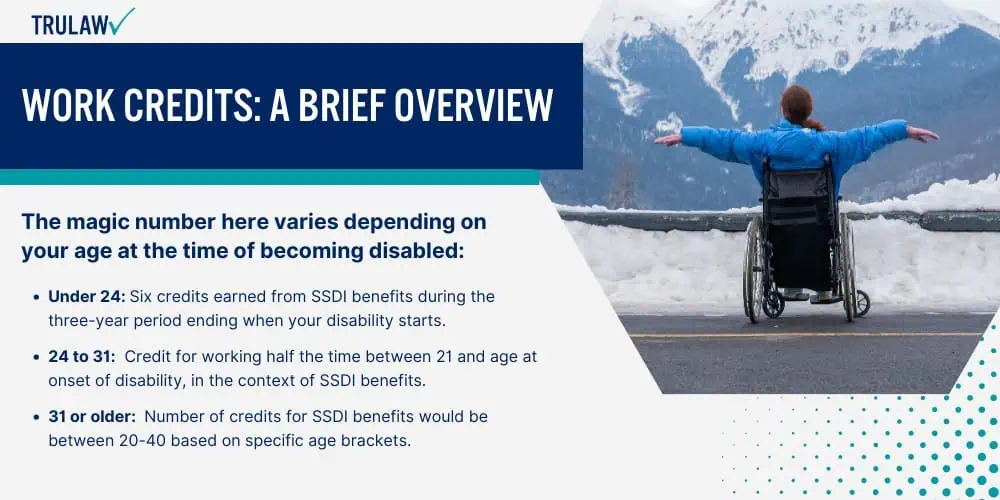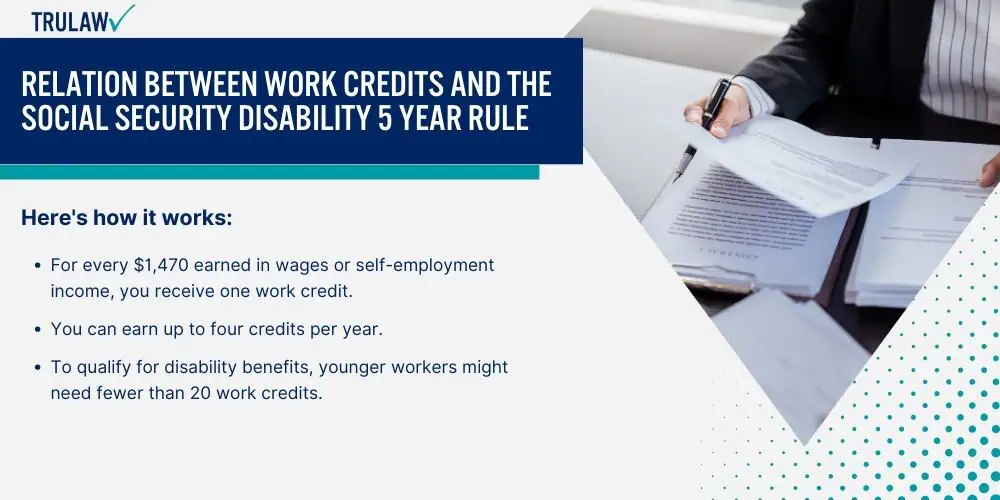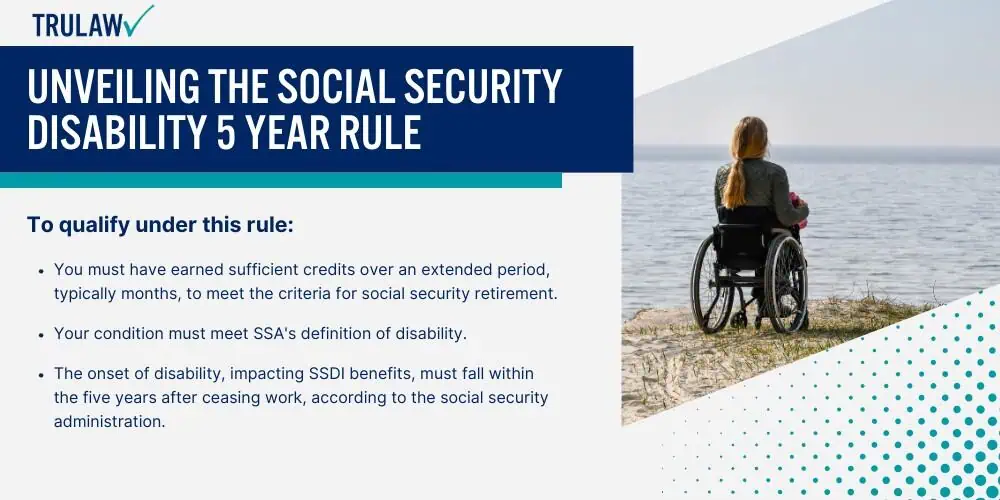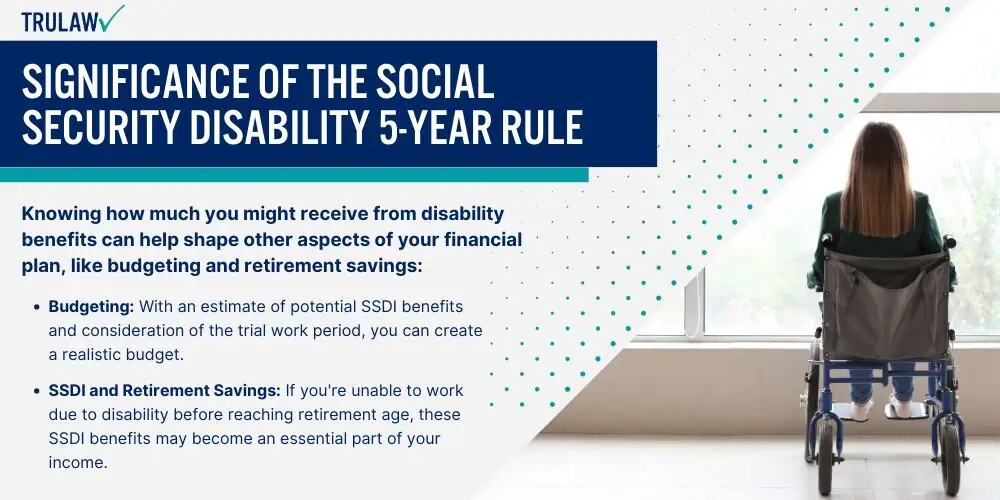FAQ: What is the Social Security Disability 5 Year Rule?
- Last Updated: December 16th, 2025

Attorney Jessica Paluch-Hoerman, founder of TruLaw, has over 28 years of experience as a personal injury and mass tort attorney, and previously worked as an international tax attorney at Deloitte. Jessie collaborates with attorneys nationwide — enabling her to share reliable, up-to-date legal information with our readers.
Legally Reviewed
This article has been written and reviewed for legal accuracy and clarity by the team of writers and legal experts at TruLaw and is as accurate as possible. This content should not be taken as legal advice from an attorney. If you would like to learn more about our owner and experienced injury lawyer, Jessie Paluch, you can do so here.
Fact-Checked
TruLaw does everything possible to make sure the information in this article is up to date and accurate. If you need specific legal advice about your case, contact us by using the chat on the bottom of this page. This article should not be taken as advice from an attorney.
Key takeaways:
- The Social Security Disability 5 Year Rule enables previous beneficiaries to skip the usual waiting period when reapplying for disability benefits.
- The Social Security Disability 5 Year Rule encourages individuals to attempt work again, knowing they can quickly regain benefits if they become unable to work within five years.
- Despite the Social Security Disability 5-Year Rule, applicants must still meet the SSA's disability definition and prove they can't engage in substantial gainful activity.
Intro to the Social Security Disability 5 Year Rule
Question: What is the Social Security Disability 5 Year Rule?
In short, the Social Security Disability 5 Year Rule allows individuals to bypass the mandatory waiting period for receiving disability benefits if they had previously received such benefits.
This rule is particularly beneficial for those who have a history of disability benefits and are seeking to reapply.

The Ins and Outs of the Social Security Disability process
Ever wondered about the ins and outs of the social security disability process, including medicare and ssi? Let’s cut to the chase.
Understanding how it works, especially the so-called ‘Social Security Disability 5 Year Rule’, is crucial for anyone with impairments reaching their full retirement age.
At its core, social security disability insurance (SSDI) provides essential benefits to those who can’t work due to a severe condition.
Here’s the catch:
Not all understand the SSI system fully, leading to common misconceptions about payments and qualifying disability.
For instance, some folks confuse their received SSDI benefits with supplemental security income or think that social security retirement benefits are identical.
Far from it!
So let’s debunk these myths and get a clear picture of what monthly SSD benefits entail, how social security taxes factor in, and where Medicare fits into this puzzle.
Stay tuned as we dive deeper into these sources.
Table of Contents
Unveiling the Social Security Disability 5 Year Rule
The 5-Year Rule Concept
The Social Security Disability 5-year rule is a product of the Social Security Administration’s (SSA) rules.
It stipulates that you must have worked and paid into social security for at least five out of the last ten years preceding your disability onset date.
Essentially, this means you’ve accumulated enough “quarters of coverage” to be eligible for benefits.
For each year you work and pay into social security benefits, you earn up to four quarters of coverage.
Hence, within a ten-year period, or forty quarters, you need twenty quarters (five years) to qualify for social security retirement under this rule.
It’s like a game where every quarter counts towards your retirement benefits! However, having a qualifying disability can also affect this.
Basic Requirements Defined by the Social Security Administration
To qualify under this rule:
- You must have earned sufficient credits over an extended period, typically months, to meet the criteria for social security retirement.
- Your condition must meet SSA’s definition of disability.
- The onset of disability, impacting SSDI benefits, must fall within the five years after ceasing work, according to the social security administration. This is crucial to consider when planning social security retirement and understanding the retirement age.
This rule also ties in with the Social Security Administration’s (SSA) “Blue Book” listing of impairments and medical conditions that automatically qualify for SSDI benefits and SSD benefits, based on specific criteria.
Role in Determining Social Security Disability Benefits
The Social Security Administration’s rule helps determine if an individual has recent enough work history to receive SSDI (Social Security Disability Insurance).
If your working months are further back than the required five out of ten years, it may be harder to get approved for SSDI.
However, there’s an extended period where some exceptions apply depending on age, potentially opening the door for SSI (Supplemental Security Income) benefits.
Common Misunderstandings
Many misunderstandings surround this rule:
- It’s not about age: Some people think this is an age-related rule because it involves ‘years’. But nope! Irrespective of your age, if you haven’t worked enough months in the relevant time frame, qualifying could be tricky.
- Not just any five years: Another misconception is that any five working years will do — wrong again! The crucial point here is that they should be within the last ten years before becoming disabled.
- Exceptions exist: Many believe there are no exceptions to this hard-and-fast rule — but there are! For instance, younger workers might not need as many work credits.
So next time you browse through SSA’s website for SSI or SSDI benefits or receive a notice about the trial work period or how social security disability benefits work in April or any other month, remember:
Don’t let these misconceptions cloud your understanding!
Unraveling the complexities of SSDI benefits, SSI, and annuity can feel like solving a Rubik’s cube without instructions.
But once understood correctly, the Social Security Disability 5-year rule and the trial work period become less daunting and more manageable!
Significance of the Social Security Disability 5-Year Rule
Impact on Benefit Eligibility and Amount
The Social Security Disability Insurance (SSDI) 5-Year rule plays a big role in determining your eligibility for benefits.
This SSDI rule states that you must have worked at least five out of the last ten years to qualify for disability benefits, or Supplemental Security Income (SSI).
If you meet this requirement, the amount you receive, which can be considered an annuity, is based on your average indexed monthly earnings during those years.
So, if you’ve had some high-earning years within that time frame, it could significantly boost your SSI benefit amount.
Influence on the Social Security Disability Insurance Claim Approval Process
When applying for SSDI disability benefits, the 5-Year rule can be a make-or-break factor in your SSDI claim approval process.
The Social Security Administration (SSA) uses this rule to determine if you have enough recent work credits for SSDI.
Without meeting this rule, even with a severe disability, your SSDI application may be denied.
Role in Maintaining Continuous Coverage
Continuity is king in the trial work period.
If there’s a gap of more than five years in your employment history due to illness or injury, it could disrupt your continuous coverage under the 5-Year Rule and affect your SSDI benefits.
It means you need to reapply and go through the entire work test process again – no one wants that!
Effect on Future Financial Planning
Finally, let’s talk dollars and sense!
The SSDI 5-Year Rule and trial work period are crucial for future financial planning.
Knowing how much you might receive from disability benefits can help shape other aspects of your financial plan, like budgeting and retirement savings:
- Budgeting: With an estimate of potential SSDI benefits and consideration of the trial work period, you can create a realistic budget.
- SSDI and Retirement Savings: If you’re unable to work due to disability before reaching retirement age, these SSDI benefits may become an essential part of your income.
So there you have it!
The Social Security Disability (SSDI) 5-year rule and the trial work period aren’t just another bureaucratic hoop to jump through — they’ve got real-life impacts on everything from qualifying for benefits right through to shaping our long-term financial plans.
Remember though — rules for SSDI benefits and the trial work period change all the time.
Everyone’s situation is unique, so always check with SSA or a trusted advisor about what applies specifically to you!
Work Credits: A Brief Overview
Work credits, often a mystery in the realm of social security disability benefits or SSDI, are a pivotal part of the eligibility criteria.
Think of them as tokens earned through your SSDI work history.

You know, like those arcade tickets you’d win and trade for prizes?
Except here, the prize is coverage under SSDI disability benefits.
Earning and Calculating Work Credits
Every job has its perks, and for workers contributing to Social Security via taxes from their wages or self-employment income, one such perk is work credits that can contribute towards your SSDI benefits.
Each year, you can earn up to four credits based on an earnings threshold set by the Social Security Administration (SSA).
Picture it like a game where every $1,470 in wages or self-employment income gets you one credit towards your SSDI benefits.
But wait!
Before you start counting your potential SSDI benefits credits, remember that there’s a cap.
No matter how much more you earn over the annual limit for SSDI benefits ($5,880 in 2021), four is the maximum number of credits per year.
Minimum Work Credits for Disability Benefits
Now let’s talk about cashing in these tokens for your prize – disability benefits eligibility.
The magic number here varies depending on your age at the time of becoming disabled:
- Under 24: Six credits earned from SSDI benefits during the three-year period ending when your disability starts.
- 24 to 31: Credit for working half the time between 21 and age at onset of disability, in the context of SSDI benefits.
- 31 or older: Number of credits for SSDI benefits would be between 20-40 based on specific age brackets.
This “work test” ensures that disabled workers have recent enough work history to qualify for temporary benefits under social security disability programs.
Work Credits vs Other Types of Credits
Don’t mistake work credits with other types of credits floating around out there.
These aren’t like academic credit hours or credit card points!
They’re unique to Social Security systems and are used solely to determine eligibility for various programs including retirement and survivor benefits along with disability coverage.
Unlike credit scores which reflect financial responsibility or college course credits which show academic progress, work credits demonstrate a worker’s contribution towards Social Security and potential eligibility for SSDI benefits based on their employment history.
It’s not about how well you did something; it’s about how long and recently you’ve been partaking in it, which can impact your SSDI benefits!
So next time someone mentions ‘work credits’, remember they’re not just some obscure jargon but rather essential tokens determining if you meet SSA’s criteria for different benefit programs!
Expiry and Accumulation of Work Credits
Time Frame for Credit Expiration
In the realm of social security disability, understanding work credits’ expiration is vital.
A common misconception is that these credits last forever; however, this isn’t the case.
Typically, work credits remain valid for a period known as your “earnings record.”
For most folks, this equates to a 5-year rule.
To put it simply: if you’ve stopped working and no longer earn income from gainful activity, your earned work credits may expire after five years.
It’s like an annuity with a waiting period that eventually runs out if not topped up.
Accumulating More Credits
Now let’s switch gears to discuss how one can accumulate additional work credits.
As a wage earner, every time you get paid for doing gainful activity and pay your Social Security taxes, you’re essentially adding to your lifetime earnings record.
For 2022, for instance, every $1,510 in earnings gives you one credit up to a maximum of four per year.
So even if you have gaps in employment or lower income years due to expenses or other reasons, there are opportunities to add more credits by returning to substantial gainful work activity.
Impact of Employment Gaps
Speaking of gaps in employment – they can be tricky.
Any period without earnings could potentially impact your ability to meet the eligibility requirements for social security disability benefits.
Say you took two years off work because life happened (as it often does).
During this time frame where no tax payments were made towards pay Social Security taxes due to lack of income from gainful activities – those are two years without new credits on your earnings record.
Consequences of Insufficient Credits
And what happens when there aren’t enough work credits?
In short: You might not qualify for social security disability benefits.
The system operates on an ‘earn-your-benefits’ basis – meaning that insufficient contributions through taxes from earnings can lead to denied claims.
However — don’t panic just yet!
There are provisions like expedited reinstatement which allow previous beneficiaries whose benefits ceased due to excess income from gainful activities another chance at approval without having to go through the standard waiting period again.
So while the accumulation and expiry process may seem daunting at first glance — remember that knowledge is power!
By understanding how these elements intertwine with each other and impact overall eligibility – navigating through the world of social security disability becomes less intimidating.
Relation Between Work Credits and the Social Security Disability 5 Year Rule
Work credits, you know those little nuggets of eligibility we earn each year?
They play a big part in the implementation of the social security disability 5-year rule.
You see, this isn’t just some arbitrary regulation.
It’s all about how much work you’ve put in.

Work Credits Influence on the 5-Year Rule
Work credits are like golden tickets to your benefit eligibility.
The more you have, the better off you’ll be.
But here’s where things get a bit tricky:
- These credits expire if not used within five (5) years, hence the infamous “5-year rule.”
Now, don’t freak out just yet.
It’s not as harsh as it sounds.
This rule is actually pretty flexible and takes into account your accumulated work credits over time.
So even if you haven’t worked for a while, your past efforts won’t go unnoticed.
Interplay Between Accumulated Credits and Benefit Eligibility
The dance between accumulated credits and benefit eligibility is quite an intricate one.
Think of it like a seesaw – when one side goes up (your accumulated credits), your chance of getting benefits also rises.
Here’s how it works:
- For every $1,470 earned in wages or self-employment income, you receive one work credit.
- You can earn up to four credits per year.
- To qualify for disability benefits, younger workers might need fewer than 20 work credits.
- Older workers typically need at least 40 work credits.
But remember that whole “use them or lose them” thing?
Yeah, that applies here too.
Combining Both Concepts in Claims Processing
When processing claims for social security disability benefits, both these concepts come into play simultaneously:
- Your total number of work credits determines if you’re eligible for benefits.
- The 5-year-rule ensures that those who have recently contributed to Social Security are prioritized.
It’s like making sure that those who’ve been regularly chipping into the pot get their fair share first.
Importance in Long-Term Disability Planning
So why does all this matter?
Well, understanding these rules is key to successful long-term disability planning:
- Knowing how many work credits are needed helps plan future employment decisions.
- Being aware of the 5-year rule encourages regular contributions towards Social Security.
It’s kind of like knowing what ingredients go into your favorite dish – once you understand what’s needed and when it needs to be added; voila!
You’ve got yourself a perfect recipe for success!
So there we have it — a quick nitty-gritty on how work credits influence the initial application process of the social security disability 5-year rule and their importance in long-term planning!
Role of a Social Security Disability Lawyer
Navigating through the maze of social security disability benefits work can feel like attempting to solve a Rubik’s cube blindfolded.
That’s where a seasoned benefits lawyer comes in handy.
Assistance with Complex Application Processes
Think about it, would you rather try to decipher complex legal jargon or have an expert guide you through the process?
A benefits lawyer is skilled at simplifying the application process for social security disability claims.
They know how to present your case in a way that increases your chances of approval.
For instance, they will help you gather necessary medical records and other documents that support your claim.
They also understand how the insurance company works and what they look for when approving or denying claims.
It’s like having a secret weapon up your sleeve!
Representation During Appeals or Disputes
Ever had someone fight tooth and nail on your behalf?
That’s what it feels like when you have a benefits lawyer representing you during your appeals process or disputes.
When an insurance company denies your claim, it can feel like David versus Goliath situation.
A knowledgeable lawyer knows how to challenge these decisions effectively.
They’re familiar with the appeal process, deadlines, and required paperwork.
Plus, they offer free consultation services so you can discuss your case without any financial commitment.
Guidance Through Legal Aspects Related to SSDI
Imagine trying to assemble IKEA furniture without instructions—it’s confusing and frustrating!
Similarly, understanding legal aspects related to Social Security Disability Insurance (SSDI) can be confusing without proper guidance.
A good lawyer doesn’t just handle paperwork; they also provide valuable insights into legal aspects related to SSDI such as eligibility criteria, benefit calculation methods etc., ensuring that all bases are covered.
Value Added by Professional Expertise
Ever tried baking cookies without following a recipe?
The results can be hit-or-miss! Similarly, navigating SSDI claims without professional expertise might not yield desired results.
The value added by professional expertise goes beyond just filing applications or handling disputes — it’s about providing personalized advice based on years of experience dealing with similar cases.
This could mean advising on potential pitfalls to avoid during application process or giving tips on improving chances of winning an appeal.
Impact of the Social Security Disability 5-Year Rule
The Social Security Disability 5-Year Rule holds a significant impact on your work credits.
These credits, both their accumulation and expiration, are directly influenced by this rule.
A clear understanding of these dynamics can play a crucial role in determining your eligibility for disability benefits.
A Social Security Disability lawyer can be an invaluable asset in navigating these complexities.
They’re equipped with the knowledge and experience to guide you through the process, ensuring you maximize your benefit potential.
In conclusion, it’s essential to grasp how the 5-year rule impacts your work credits and ultimately your eligibility for social security disability benefits.
Don’t hesitate to seek professional help if needed; it might make all the difference!
Take Action Now!
Equip yourself with knowledge and secure professional guidance if necessary.
Remember, understanding is power when dealing with social security rules.
Social Security Disability Insurance Frequently Asked Questions
-
The Social Security Disability 5-Year Rule is a crucial aspect of disability benefits.
The key points to understand for the Social Security Disability 5 Year Rule are:
- It allows people to potentially bypass the standard waiting period.
- This rule applies to people who had previously received disability benefits.
Bypasses Usual Waiting Period:
The Social Security Disability 5-Year Rule allows individuals to bypass a required waiting period for receiving disability benefits.
This means that if a person’s disability recurs within five years, they can start receiving benefits immediately without having to go through the typical waiting period.
This provision is particularly beneficial for individuals whose disabilities are intermittent or prone to recurrence, enabling them to receive support promptly when they need it.
Applies to Previous Beneficiaries:
The rule is applicable if the applicant had previously received disability benefits.
Specifically, if a person had been a beneficiary of Social Security disability benefits in the past, they are eligible for immediate reinstatement of benefits under the 5-Year Rule if their disability recurs.
This aspect of the rule acknowledges the ongoing nature of certain disabilities and provides a safety net for individuals who might need to access benefits again.
To conclude, the Social Security Disability 5 Year Rule simplifies the process of receiving benefits for previous beneficiaries, providing immediate support in the event of a recurring disability.
-
Waiting periods are a part of the Social Security Disability Insurance (SSDI) benefits process.
The waiting period for Social Security Disability Insurance (SSDI) benefits works like this:
- There is an initial (5) month waiting period before benefits are paid.
- The first benefit is paid the sixth (6th) full month after the date the disability began.
5-Month Waiting Period:
Yes, there is generally a 5-month waiting period for SSDI benefits.
This waiting period begins from the “onset date” of your disability, or the date you became unable to work due to your medical condition.
The purpose of this waiting period is to ensure that benefits are not paid to people with short-term disabilities.
However, it’s important to note that this waiting period does not apply if you are reapplying for benefits within five years of previously receiving them.
Benefits Paid from Sixth Month:
The first benefit is paid the sixth full month after the date the disability began.
This means that if your disability began in January, for example, your first benefit would be paid in July.
It’s important to understand that Social Security benefits are paid a month behind, so you’ll receive your July benefit in August.
This schedule applies regardless of the date in the month that your disability began.
To conclude, while there is a waiting period for SSDI benefits, there are also provisions in place to ensure that those with recurring disabilities can receive their benefits promptly.
-
Qualifying for Social Security Disability Insurance (SSDI) benefits involves certain criteria.
The key criteria for qualifying for Social Security Disability Insurance (SSDI) are:
- You must work in jobs covered by Social Security.
- You must have a medical condition that meets Social Security’s definition of a “disability.”
Work in Jobs Covered by Social Security:
To qualify for SSDI benefits, you must have worked in jobs covered by Social Security.
This means that you have been employed in a job where you paid Social Security taxes.
The Social Security Administration (SSA) uses a system of “credits” to determine if you have worked enough to qualify for benefits.
As of 2023, you earn one credit for each $1,470 in earnings, up to a maximum of four credits per year.
Have a Medical Condition that Meets Social Security’s Definition of Disability:
You must have a medical condition that meets Social Security’s strict definition of disability.
The SSA defines disability as the inability to engage in any substantial gainful activity (SGA) due to a medically determinable physical or mental impairment(s) that is expected to result in death, or that has lasted or is expected to last for a continuous period of at least 12 months.
The SSA maintains a list of medical conditions that are considered so severe they automatically mean you are disabled.
If your condition is not on the list, the SSA has to decide if it is of equal severity to a medical condition that is on the list.
To conclude, qualifying for SSDI benefits requires having worked in Social Security-covered employment and having a medical condition that meets the SSA’s definition of disability.
-
Returning to work while receiving Social Security disability benefits is a common concern for beneficiaries.
Here are the key points to understand if you share this concern:
- Special rules allow work without jeopardizing benefits.
- These rules include a nine (9) month Trial Work Period.
Special Rules Allow Work Without Jeopardizing Benefits:
Yes, you can return to work while receiving Social Security disability benefits.
The Social Security Administration (SSA) has special rules called “work incentives” that provide continued benefits and health care coverage to help you make the transition back to work.
These rules allow you to test your ability to work, or even to start a new line of work, while still receiving monthly SSDI benefits.
Includes a Nine-Month Trial Work Period:
One of these work incentives includes a nine-month Trial Work Period (TWP) to test your ability to work.
During the TWP, you can receive full SSDI benefits regardless of how much you earn as long as your work activity is reported and you continue to have a disabling impairment.
The TWP allows you to test your ability to work for at least nine months.
To conclude, the Social Security Administration provides flexibility for beneficiaries to return to work through special rules and incentives, ensuring that transitioning back to work does not mean an immediate end to benefits.
However, this can differ on a case by case basis — it’s best to contact an SSDI Lawyer to discuss your situation before rushing to any decisions like these.
-
This is a common question for Social Security disability benecieries who are approaching retirement age.
Here are the key points to understand for how SSDI benefits work when you reach retirement age:
- Disability benefits change to retirement benefits when you reach retirement age.
- The law does not allow a person to collect both benefits simultaneously.
Disability Benefits Change to Retirement Benefits:
Social Security disability benefits automatically transition to retirement benefits when disability beneficiaries reach full retirement age.
This transition happens automatically and does not require any action on your part.
The amount of the benefit does not decrease — it continues at the same rate as before, but it is now classified as a retirement benefit rather than a disability benefit.
Occurs at Full Retirement Age:
The law does not allow a person to receive both retirement and disability benefits on one earnings record at the same time.
This transition occurs when you reach your full retirement age, which varies depending on the year you were born.
For example, for people born between 1943 and 1954, the full retirement age is 66.
For those born after 1960, it’s 67.
To conclude, when you reach full retirement age, your Social Security disability benefits automatically transition to retirement benefits.
You won’t receive both benefits simultaneously, but your total benefit amount will remain the same.
-
The automatic change from Social Security disability benefits to retirement benefits has specific implications.
The key implications to know are:
- Social Security disability benefits automatically change at full retirement age.
- An individual cannot receive both benefits simultaneously.
Automatic Change at Full Retirement Age:
Social Security disability benefits automatically change to retirement benefits when disability beneficiaries reach full retirement age.
This transition is automatic and does not require any action on the part of the beneficiary.
The change is essentially a reclassification of the benefit from disability to retirement, but the amount of the benefit remains the same.
Cannot Receive Both Benefits Simultaneously:
The law does not allow a person to receive both retirement and disability benefits on one earnings record at the same time.
This means that once you reach full retirement age and your disability benefits transition to retirement benefits, you will no longer receive disability benefits.
However, the total amount of your benefits will not decrease — it will continue at the same rate as your disability benefit.
To conclude, when you reach full retirement age, your Social Security disability benefits will automatically transition to retirement benefits.
You won’t receive both benefits simultaneously, but your total benefit amount will remain the same.
-
The 5-Year Rule in Social Security Disability is significant for a couple of reasons.
The key points of significane are:
- The 5-Year Rule in Social Security Disability simplifies the reapplication process for individuals.
- The 5-Year Rule in Social Security Disability is particularly beneficial to individuals with intermittent work history.
Simplifies Reapplication Process:
The Social Security Disability 5-Year Rule simplifies the reapplication process for those who have worked intermittently but have a disability that, more than once within five years, has prevented them from working.
This rule allows individuals to bypass the standard waiting period for disability benefits, making it easier for them to access the support they need.
It recognizes the challenges faced by individuals with intermittent disabilities and aims to reduce the barriers they face in accessing benefits.
Applies to Individuals with Intermittent Work History:
The 5-Year Rule is particularly beneficial for individuals with an intermittent work history due to their disability.
These individuals may have periods of employment interrupted by periods of disability, making it difficult for them to meet the standard requirements for disability benefits.
The 5-Year Rule acknowledges this unique work pattern and provides a more accessible path to benefits.
To conclude, the 5-Year Rule in Social Security Disability plays a significant role in the reapplication process for Social Security Disability benefits.
It is particularly beneficial to people who have been in and out of work due to their disability, providing a more accessible path to the support they need.
-
The Social Security Disability 5-Year Rule has a direct impact on disability benefits.
Disability benefits are impacted by the Social Security Disability 5-Year Rule in the following ways:
- Previous disability beneficiaries can automatically resume their benefits without reapplication.
- Previous disability beneficiaries can enjoy this “convenience” when their income falls beneath the “substantial gainful activity” threshold, established by the SSA.
Resumption of Benefits Without Reapplication:
If, at any time, within five (5) years of your benefits being stopped, your income again falls beneath the level the SSA sets as “substantial gainful activity,” you can resume your monthly SSDI benefits without needing to reapply.
The SSA sets a new threshold for “substantial gainful activity” each year.
The Social Security Disability 5-Year Rule is particularly beneficial for individuals whose income fluctuates due to their disability — especially given the length and complexities of the initial application process.
To conclude, the 5-Year Rule can significantly impact the process and timeline of receiving disability benefits for previous disability beneficiaries who now qualify again.
-
Special rules exist to allow work without jeopardizing Social Security disability benefits.
These special rules allow current Social Security Disability Insurance (SSDI) beneficiaries to:
- Return to work without fear of losing their benefits in the event they can no longer work after attempting to.
- This includes a nine (9) month Trial Work Period to test your ability to work.
These special rules provide flexibility for beneficiaries who wish to return to work, but are hesitant to out of fear of losing their benefits.
This fear is understandable, especially when beneficiaries need to provide for their families and can’t afford to lose their benefits in the event their disability forces them out of work again.
However, things can differ on a case by case basis — it’s best to contact an SSDI Lawyer to discuss your situation before rushing to any decisions like these.

Managing Attorney & Owner
With over 25 years of legal experience, Jessica Paluch-Hoerman is an Illinois lawyer, a CPA, and a mother of three. She spent the first decade of her career working as an international tax attorney at Deloitte.
In 2009, Jessie co-founded her own law firm with her husband – which has scaled to over 30 employees since its conception.
In 2016, Jessie founded TruLaw, which allows her to collaborate with attorneys and legal experts across the United States on a daily basis. This hypervaluable network of experts is what enables her to share the most reliable, accurate, and up-to-date legal information with our readers!
Additional Social Security Disability Insurance resources on our website:
Here, at TruLaw, we’re committed to helping victims get the justice they deserve.
Alongside our partner law firms, we have successfully collected over $3 Billion in verdicts and settlements on behalf of injured individuals.
Would you like our help?
At TruLaw, we fiercely combat corporations that endanger individuals’ well-being. If you’ve suffered injuries and believe these well-funded entities should be held accountable, we’re here for you.
With TruLaw, you gain access to successful and seasoned lawyers who maximize your chances of success. Our lawyers invest in you—they do not receive a dime until your lawsuit reaches a successful resolution!
AFFF Lawsuit claims are being filed against manufacturers of aqueous film-forming foam (AFFF), commonly used in firefighting.
Claims allege that companies such as 3M, DuPont, and Tyco Fire Products failed to adequately warn users about the potential dangers of AFFF exposure — including increased risks of various cancers and diseases.
Depo Provera Lawsuit claims are being filed by individuals who allege they developed meningioma (a type of brain tumor) after receiving Depo-Provera birth control injections.
A 2024 study found that women using Depo-Provera for at least 1 year are five times more likely to develop meningioma brain tumors compared to those not using the drug.
Suboxone Tooth Decay Lawsuit claims are being filed against Indivior, the manufacturer of Suboxone, a medication used to treat opioid addiction.
Claims allege that Indivior failed to adequately warn users about the potential dangers of severe tooth decay and dental injuries associated with Suboxone’s sublingual film version.
Social Media Harm Lawsuits are being filed against social media companies for allegedly causing mental health issues in children and teens.
Claims allege that companies like Meta, Google, ByteDance, and Snap designed addictive platforms that led to anxiety, depression, and other mental health issues without adequately warning users or parents.
Transvaginal Mesh Lawsuits are being filed against manufacturers of transvaginal mesh products used to treat pelvic organ prolapse (POP) and stress urinary incontinence (SUI).
Claims allege that companies like Ethicon, C.R. Bard, and Boston Scientific failed to adequately warn about potential dangers — including erosion, pain, and infection.
Bair Hugger Warming Blanket Lawsuits involve claims against 3M — alleging their surgical warming blankets caused severe infections and complications (particularly in hip and knee replacement surgeries).
Plaintiffs claim 3M failed to warn about potential risks — despite knowing about increased risk of deep joint infections since 2011.
Baby Formula NEC Lawsuit claims are being filed against manufacturers of cow’s milk-based baby formula products.
Claims allege that companies like Abbott Laboratories (Similac) and Mead Johnson & Company (Enfamil) failed to warn about the increased risk of necrotizing enterocolitis (NEC) in premature infants.
Here, at TruLaw, we’re committed to helping victims get the justice they deserve.
Alongside our partner law firms, we have successfully collected over $3 Billion in verdicts and settlements on behalf of injured individuals.
Would you like our help?



